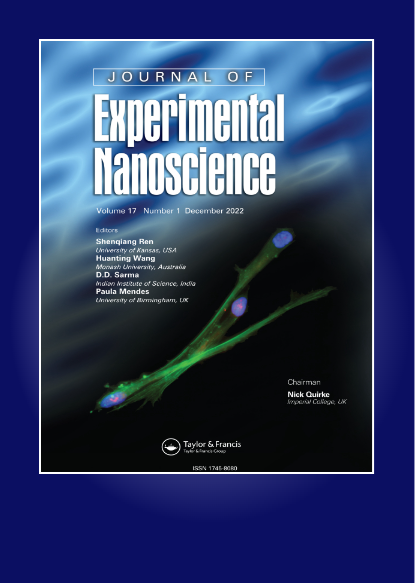Describing a modern therapeutic drug prepared by in situ decorated gold nanoparticles on starch-modified magnetic nanoparticles to treat the cutaneous wound: a preclinical trial study
IF 2.8
4区 材料科学
Q2 CHEMISTRY, MULTIDISCIPLINARY
引用次数: 4
Abstract
Abstract In recent days, the green synthesized nanomagnetic biocomposites have been evolved with tremendous potential as the future catalysts. This has encouraged us to design and synthesis of a novel Au NP fabricated starch functionalized core-shell type nanomaterial (Fe3O4/Starch-Au nanocomposite). It was meticulously characterized using advanced analytical techniques like FT-IR, FESEM, TEM, EDX, VSM, XRD and ICP-OES. MTT assay was used on common normal cell line i.e. Human umbilical vein endothelial cells (HUVEC) to survey the cytotoxicity effects of Fe3O4/Starch-Au nanocomposite. In the part of cutaneous wound healing, use of Fe3O4/Starch-Au nanocomposite ointment, significantly (p ≤ 0.01) raised the wound contracture, vessel, hydroxyl proline, hexuronic acid, fibrocyte, fibroblast, and fibrocytes/fibroblast rate and significantly (p ≤ 0.01) decreased the wound area, total cells, neutrophil, and lymphocyte compared to other groups in rats. Finally, the results showed the useful cutaneous wound healing properties of Fe3O4/Starch-Au nanocomposite. Maybe significant cutaneous wound healing potentials of Fe3O4/Starch-Au nanocomposite are related to their antioxidant activities. For investigating the antioxidant activities of Fe3O4/Starch-Au nanocomposite, the DPPH test was used in the presence of butylated hydroxytoluene as the positive control. The Fe3O4/Starch-Au nanocomposite inhibited half of the DPPH molecules in the concentration of 156 µg/mL.描述一种由淀粉修饰的磁性纳米颗粒上原位修饰的金纳米颗粒制备的治疗皮肤创伤的现代治疗药物:临床前试验研究
近年来,绿色合成的纳米磁性生物复合材料作为未来的催化剂具有巨大的发展潜力。这鼓励我们设计和合成一种新型的金NP淀粉功能化纳米材料(Fe3O4/淀粉-金纳米复合材料)。采用FT-IR, FESEM, TEM, EDX, VSM, XRD和ICP-OES等先进分析技术对其进行了细致的表征。采用MTT法对普通正常细胞系人脐静脉内皮细胞(HUVEC)进行细胞毒性研究,探讨Fe3O4/淀粉-金纳米复合材料的细胞毒性作用。在皮肤创面愈合部分,应用Fe3O4/淀粉-金纳米复合软膏可显著(p≤0.01)提高创面挛缩、血管、羟脯氨酸、己糖酸、纤维细胞、成纤维细胞和成纤维细胞/成纤维细胞率,显著(p≤0.01)降低创面面积、总细胞、中性粒细胞和淋巴细胞。结果表明,Fe3O4/淀粉-金纳米复合材料具有良好的皮肤伤口愈合性能。Fe3O4/淀粉-金纳米复合材料具有显著的皮肤伤口愈合潜力,可能与其抗氧化活性有关。为了研究Fe3O4/淀粉-金纳米复合材料的抗氧化活性,采用DPPH试验,以丁基羟基甲苯为阳性对照。Fe3O4/淀粉- au纳米复合材料在浓度为156µg/mL时抑制了一半的DPPH分子。
本文章由计算机程序翻译,如有差异,请以英文原文为准。
求助全文
约1分钟内获得全文
求助全文
来源期刊

Journal of Experimental Nanoscience
工程技术-材料科学:综合
CiteScore
4.10
自引率
25.00%
发文量
39
审稿时长
6.5 months
期刊介绍:
Journal of Experimental Nanoscience, an international and multidisciplinary journal, provides a showcase for advances in the experimental sciences underlying nanotechnology and nanomaterials.
The journal exists to bring together the most significant papers making original contributions to nanoscience in a range of fields including biology and biochemistry, physics, chemistry, chemical, electrical and mechanical engineering, materials, pharmaceuticals and medicine. The aim is to provide a forum in which cross fertilization between application areas, methodologies, disciplines, as well as academic and industrial researchers can take place and new developments can be encouraged.
 求助内容:
求助内容: 应助结果提醒方式:
应助结果提醒方式:


